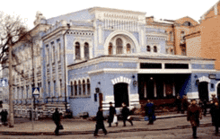Brodsky Synagogue
| Brodsky Synagogue | |
|---|---|
 | |
| Basic information | |
| Location |
|
| Affiliation | Orthodox Judaism |
| Status | Active |
| Architectural description | |
| Architect(s) | Georgiy Shleifer |
| Architectural style | Romanesque Revival with elements of Moorish Revival |
| Completed | 1898 |
The Brodsky Choral Synagogue is the largest synagogue in Kiev, Ukraine. It was built in the Romanesque Revival style resembling a classical basilica.[1] The original tripartite facade with a large central avant-corps flanked by lower wings also echoed the characteristic design of some Moorish Revival synagogues, such as the Leopoldstädter Tempel in Vienna.
History
The synagogue was built between 1897 and 1898. It was designed by Georgiy Shleifer. A sugar magnate and philanthropist Lazar Brodsky financed its construction.[2][3]
For many decades the local and imperial authorities forbade the construction of a monumental place of Jewish worship in Kiev, as they feared that this would facilitate the growth of the Jewish community in Kiev, which, being a big trading and industrial city, would then become an important Jewish religious center. This was considered "undesirable" due to the symbolic importance of Kiev, as the cradle of Russian Orthodoxy. It was only allowed to convert existing buildings into Jewish worship houses.
In 1895, permission was given to build a synagogue in the Podil district, a poor quarter of Kiev. The location was however too far from the city center where the wealthy Jews lived such that they could not walk there on Sabbath. They wished a big choral synagogue in the city center, similar to those in St. Petersburg, Moscow and Odessa.[3]
To evade the ban, Brodsky and rabbi Evsey Tsukerman sent a complaint to the Governing Senate requesting a permission to build a worship house in the private estate of Brodsky. As an attachment they included only a side view drawing of the planned building which looked like a private mansion.[3][4][5][6] The permission was obtained, and the synagogue became an example of an Aesopian synagogue.
In 1926, the synagogue was closed down by the Soviet authorities. The building was converted into an artisan club.[5][7]
The building was devastated during the World War II by Nazis and was subsequently used as a puppet theatre.[5][3] An additional facade was built in the 1970s.
In 1997 the theatre moved into a new building. The old building was renovated and since 2000 it is again used as a synagogue.[2][5][6] The restoration was mainly financed by a media proprietor Vadim Rabinovich.[6] Currently it serves a Chabad-Lubavitch congregation.
Gallery
| Wikimedia Commons has media related to Brodsky Synagoge. |
-

Postcard, 1909
-

Puppet theater in the 1970s
-
Bird's eye view today
-

The Holy Ark of the synagogue
-

The Parochet of the Holy Ark
See also
References
- ↑ Виталий Ковалинский. Синагога Лазаря Бродского. Уикэнд, 30.08.2013 (Vitaliy Kovalinskiy. Lazar Brodsky Synagogue. Weekend, August 30, 2013; in Russian)
- 1 2 Rededicated Kiev synagogue to serve as community center
- 1 2 3 4 Victoria Khiterer (2008). The Social and Economic History of Jews in Kiev Before February 1917 (Thesis). Brandeis University. Near Eastern and Judaic Studies. ProQuest. pp. 214–216. ISBN 9780549771005.
- ↑ Выставка «Еврейская община Киева. Люди и Город». Институт иудаики, Киев, 2013 (Exhibition "Jewish community of Kiev. The people and the city." Institute of Judaism, 2013; in Russian)
- 1 2 3 4 Мерой света и молитвы. Aгентство еврейских новостей, Киев, 2008 (Jewish news agency, Kiev, 2008; in Russian)
- 1 2 3 Синагога Бродского. MyKiev (in Russian)
- ↑ Синагогу под клуб. Иллюстрированная Россия, Выпуск № 50 (83), 1926, стр. 16 (Synagogue for a club. Illustrated Russia, 50 (83), 1926, p. 16; in Russian)
External links
Coordinates: 50°26′19.14″N 30°31′13.5″E / 50.4386500°N 30.520417°E
